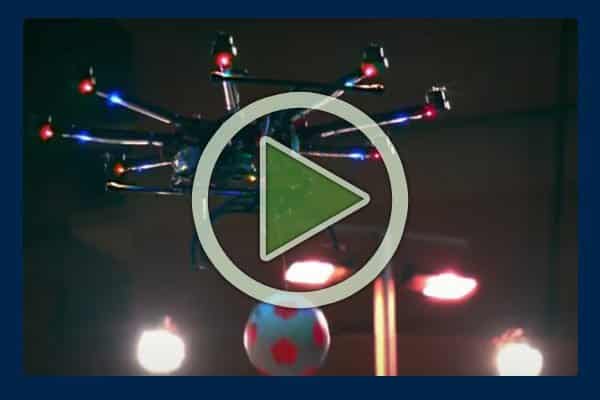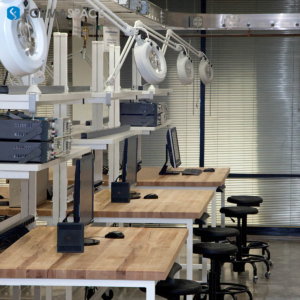The convergence of wireless Internet, smart phone controllers, miniaturization of electronic components such as video cameras, batteries and motors has set the stage for an explosion in drone technology. As engineering design projects, drones are an endlessly fascinating subject — combining the thrill of piloting remote-controlled airplanes with the snooping capability of aerial photography.
This past week, Walmart was in the news. It was widely reported that Walmart, like Amazon, intends to test package delivery using drones. This is an interesting development, particularly for the large number of Formaspace clients that use our custom furniture solutions in their distribution centers. Interestingly, the Singapore Postal Service, known as SingPost, is already testing an alpha version of their mail and parcel delivery service.
This proof-of-concept test identifies several of the key elements necessary for a successful package delivery system, including integrated smart phone apps to control the flight-path and secure locking devices on the drone itself to ensure delivery to the intended recipient. Urgent package delivery has been on the forefront of technology for centuries, going back to the original “Clipper” ships bringing mail across the Atlantic, to the famous “Pony Express” and fast stagecoach mail services across the West, to New York City’s pneumatic tube system to today’s ubiquitous urban bicycle courier services and overnight package delivery services pioneered by FedEx.

What Have Drones Been Up to Lately?
Whenever there’s a new and interesting cultural phenomenon, advertisers and marketers are soon to follow. In the commercial clip above from the soft drink giant Pepsi, the flying drone performs the starring role — dropping the ball on the court below — in an eye-catching multimedia extravaganza of projection and LED lighting wizardry. Already, advertisers are experimenting with using flying drones to project large images on buildings as part of advertising campaigns.
At the risk of repeating ourselves from last week, when we celebrated Back to the Future Day, this drone enabled future before us looks remarkably like the 1982 film Blade Runner. Blade Runner was set in a fictitious 2019 version of Los Angeles. With only four years to go, it looks like many of the film’s startling predictions, such as human cloning and flying drones, will feel like familiar territory to us when 2019 arrives.
For those of you that remember the Blade Runner film, it was exciting and novel but at the same time offered up a potentially dark vision of the future. Similarly, drones have a multi-personality. Artists have used them to create unique theatrical works of art, such as the beautiful drone courtship video.
Drones can offer assist to First Responders trying to gauge the scope of a disaster or when undertaking life-saving search-and-rescue operations. Drone cameras captured the immense power of the recent mudslides affecting Southern California during this El Niño wet season.
Unfortunately with the good, comes the bad. Increasingly, firefighters and First Responders are encountering hobbyists’ rogue drones, which have already interfered with firefighting operations in northern California. An awareness campaign has been started to convince unauthorized drone operators to keep their flying vehicles away from emergency operations.
The Dark Side of Drones
Industrial use of drones is another problematic area. The positive uses of drones are clear: geographers can use drones to help map remote locations and identify resources for exploitation or conservation. Construction companies can use drones to photograph and manage complex construction sites. On the other hand, drones can also be used for spying in industrial espionage cases. Remote proving grounds in the desert, or secret test tracks used by automobile manufacturers are now at risk for spying from drone aircraft.
One’s own individual privacy is also at risk. Celebrities were among the first to experience this new level of invasion of privacy. Hollywood Paparazzi have been employing airborne drones to capture private moments of famous people. In response, California Gov. Jerry Brown recently signed a new law prohibiting paparazzi from using drones in this manner. In the short clip above, entertainer Conan O’Brien expresses his outrage against drones in a humorous manner. His sidekick takes a baseball bat and destroys the drone at the end of the clip. This is not an uncommon reaction.

Earlier this year a drone was discovered filming a group of sunbathers on Huntington Beach in Southern California. According to one of the beach-goers, the drone was hovering just a few feet above them, and one individual walking on the boardwalk became so enraged he bashed the drone with his T-shirt — which got caught up in its propellers, causing it to crash. This scene was caught on film by the drone pilot who reportedly contacted police.
Incredibly, the police took the person who threw the t-shirt at the drone away to the police station, where they considered charging him with destruction of private property. To date, no charges have been filed. The T-shirt versus drone incident is fairly benign. No one was injured. And no one was injured in Washington DC earlier this year when a federal employee reportedly flew his large drone in downtown District of Columbia in the middle of the night. As it turns out, it crashed on the lawn of the White House after hitting a tree. This incident however was a wake-up call to the Secret Service, because it doesn’t take too much of a stretch of imagination to consider the horrible consequences of a drone bearing some kind of attack payload, be it a chemical weapon or explosive device.
The Federal Government’s Department of Transportation (DOT) and Federal Aviation Administration (FAA) has been struggling to come up with rules that will allow the positive commercial aspects of drone operations while protecting traditional passenger aircraft, as well as our security interests. In the video clip above, DOT and FAA officials announced they are currently developing drone registration rules and hope to have them ready for presentation by November 20 of this year.
It’s not clear if simple registration will be sufficient. Some critics believe that the microchip controllers from the manufacturers should have no-fly zones programmed into the devices. This so-called geo-fencing approach would prevent the drone craft from crossing security borders, such as those surrounding major airports or government facilities. Others say that, like the Volkswagen hacking scandal for diesel emission controls, it’s very easy to reprogram electronic devices and these new regulations would not provide significant security benefits. We’re curious to hear what you think.
Formaspace is Ready for the Future

Join the roster of satisfied Formaspace clients — including Apple Computer, Boeing, Dell, Eli Lilly, Exxon Mobile, General Electric, Intel, Lockheed Martin, Medtronic, NASA, Novartis, Stanford University, Toyota and more. Give us a call today at 800.251.1505 to find out more about the Formaspace line of stock, semi-custom and custom-made computer workstations, industrial workbenches, laboratory furniture, lab benches and dry lab/wet labs — as well as our design / furniture consulting services. Our American-made technical furniture solutions are flexible, reconfigurable and long-lasting. Like all Formaspace furniture, it’s backed by our famous 12 year, three shift guarantee.







